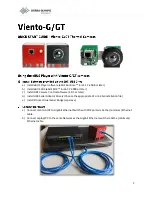
Figure 8.2
Two-point correction.
8.1.4
One-point correction (offset correction)
8.1.4.1
General
The NUC correction is strongly dependent on the optical path in front of the detector,
and on the detector setup itself. Often, any change in the camera or detector settings will
require a new NUC. However, this change is mainly in the offset response of the image
while the gain component stays constant. An offset update simply computes a new offset
coefficient using the existing gain coefficient and corrects the image non-uniformity. An
offset update requires only one uniform source, usually set at a temperature on the lower
edge of the operational range.
One-point correction is done when clicking the calibrate button in the ResearchIR Max
camera tab (11 in Figure 6.2
8.2
Temperature calibration
8.2.1
Hypercal
8.2.1.1
General
Hypercal is a proprietary temperature measurement process that complements CNUC.
With Hypercal, for any integration time selected, the camera produces accurate meas-
urement within ±1°C or ±1% over the configured measurement range. Therefore, it
makes the selection of the optimal measurement range for a given thermal scene an
easy task.
Note
±1°C or ±1% accuracy is standard for the FLIR X6530sc, unless explicitly speci-
fied otherwise. Typically, calibration on custom spectral filters or custom optical configu-
rations have higher-accuracy tolerances.
8.2.2
Auto-exposure
8.2.2.1
General
Because the dynamic range of a natural thermal scene can be larger than the range of
the camera, some images taken by the camera may be saturated. When an image is in
the bottom part of the dynamic range, the sensitivity is affected; therefore, the integration
time has to be increased. Conversely, when an image is in the higher part of the dynamic
range and saturated, the integration time has to be decreased.
When activated, the camera will search for the highest integration time for which the im-
age dynamic range is contained in the upper part of the linearity domain of the detector.
Auto-exposure can be started from ResearchIR Max (see section 6.4.5
, page 24) or from the LCD screen (see Figure 6.1
page 17).
#T810206; r. AA/43064/43088; en-US
37
Содержание X6530sc Series
Страница 1: ...User s manual FLIR X6530sc series...
Страница 2: ......
Страница 3: ...User s manual FLIR X6530sc series T810206 r AA 43064 43088 en US iii...
Страница 4: ......
Страница 65: ...Mechanical drawings 10 See next page T810206 r AA 43064 43088 en US 57...
Страница 117: ......
















































